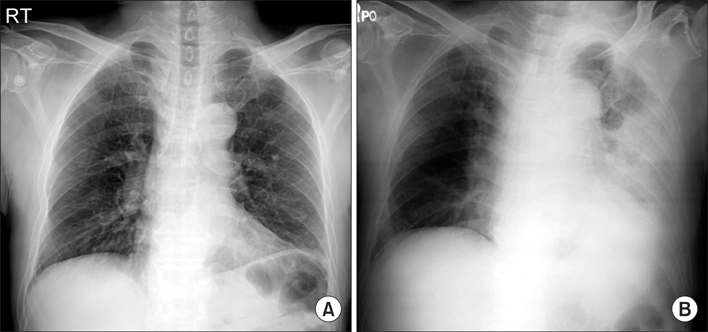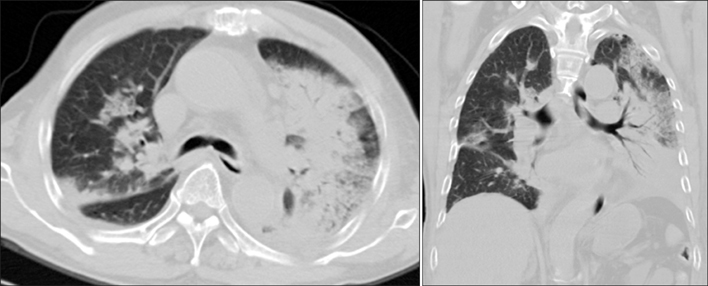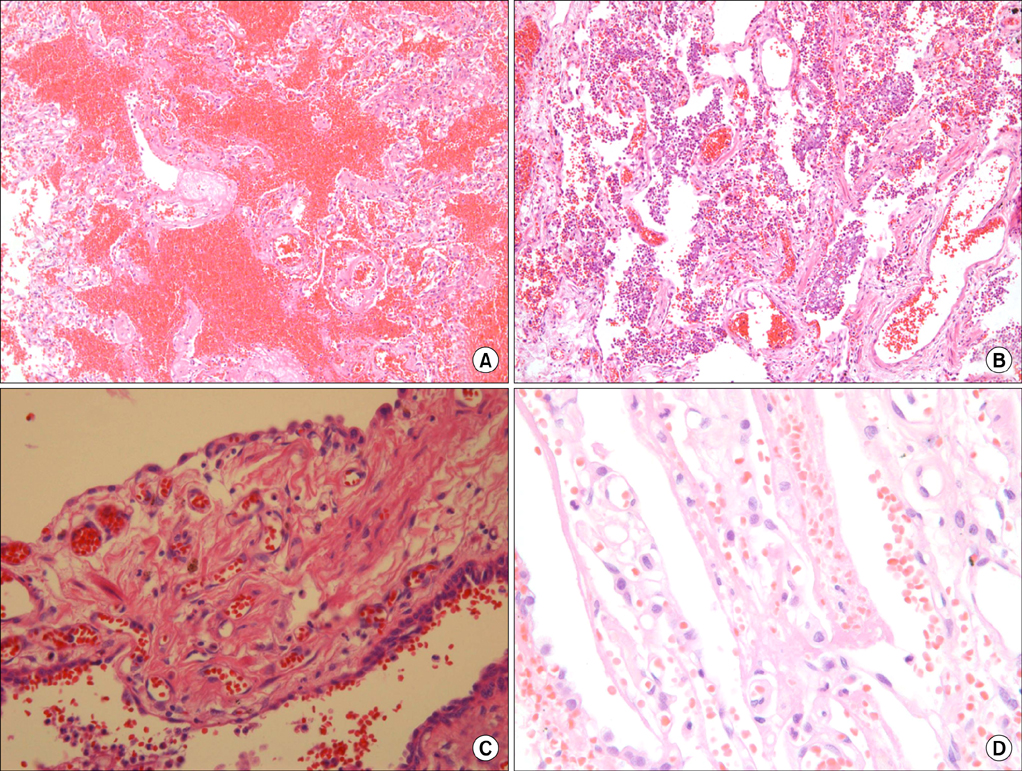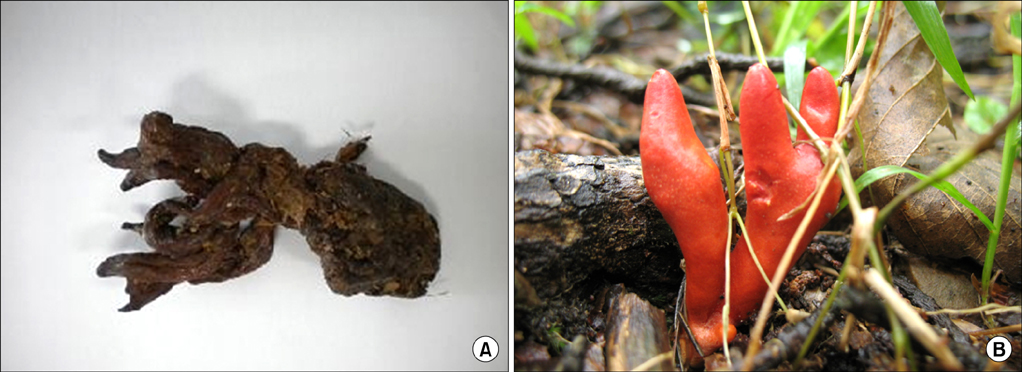Tuberc Respir Dis.
2013 Dec;75(6):264-268.
An Elderly Man with Fatal Respiratory Failure after Eating a Poisonous Mushroom Podostroma cornu-damae
- Affiliations
-
- 1Department of Internal Medicine, Hallym University College of Medicine, Chuncheon, Korea. kimch2002@hallym.or.kr
- 2Department of Pathology, Hallym University College of Medicine, Chuncheon, Korea.
- 3Department of Thoracic and Cardiovascular Surgery, Hallym University College of Medicine, Chuncheon, Korea.
- 4Department of Pathology, Sungkyunkwan University School of Medicine, Seoul, Korea.
- 5Agricultural Microbiology Department, National Academy of Agricultural Science, Rural Development Administration, Suwon, Korea.
Abstract
- A 73-year-old, previously healthy man presented with nausea, vomiting, diarrhea, dry mouth and febrile sensation 3 hours after eating boiled wild mushrooms. After admission, he showed progressive severe respiratory distress, pancytopenia, azotemia, hypotension, hypoxemia and consolidation of the entire left lung on chest radiography. With a preliminary diagnosis of necrotizing pneumonia, he underwent left pneumonectomy in order to remove all necrotic lung tissue. Lung histology showed extensive hemorrhagic necrosis, massive inflammatory cell infiltration, prominent proliferation of young fibroblasts and the formation of an early-stage hyaline membrane along the alveolar wall. Despite aggressive treatment, including mechanical ventilation, continuous renal replacement therapy and administration of granulocyte colony stimulating factor and broad spectrum antibiotics, he died on hospitalization day 13. Subsequently, the mushroom was identified as Podostroma cornu-damae. This is the first case of a histological evidence of lung involvement by Podostroma cornu-damae poisoning in Korea.
Keyword
MeSH Terms
-
Agaricales*
Aged*
Anoxia
Anti-Bacterial Agents
Azotemia
Colony-Stimulating Factors
Diagnosis
Diarrhea
Eating*
Fibroblasts
Granulocytes
Hospitalization
Humans
Hyalin
Hypotension
Korea
Lung
Membranes
Mouth
Mushroom Poisoning
Nausea
Necrosis
Pancytopenia
Pneumonectomy
Pneumonia
Poisoning
Radiography
Renal Replacement Therapy
Respiration, Artificial
Respiratory Insufficiency*
Sensation
Thorax
Vomiting
Anti-Bacterial Agents
Colony-Stimulating Factors
Figure
Reference
-
1. Gonmori K, Yoshioka N, et al. The examination of mushroom poisonings at Akita University. Leg Med (Tokyo). 2003; 5 Suppl 1:S83–S86.2. Faulstich H. Mushroom poisoning. Lancet. 1980; 2:794–795.3. Yokoyama K, Gonmori K. Increase of poisoning by tropical mushrooms in Japan in recent years. Chudoku Kenkyu. 2009; 22:240–248.4. Izawa H. Podostroma cornu-damae (Pat.). Mycobank International Mycological Association;1994.5. Patouillard NT. Enumération des champignons récoltés par les RR. PP. Farges et Soulié, dans le Thibet oriental et le Sutchuen. Bull Soc Mycol Fr. 1895; 11:196–199.6. Saikawa Y, Okamoto H, Inui T, Makabe M, Okuno T, Suda T, et al. Toxic principles of a poisonous mushroom Podostroma cornu-damae. Tetrahedron. 2001; 57:8277–8281.7. Ahn JY, Seok SJ, Song JE, Choi JH, Han SH, Choi JY, et al. Two cases of mushroom poisoning by Podostroma cornu-damae. Yonsei Med J. 2013; 54:265–268.8. Mogi K, Takeshita H, Yasuda T, Nakajo S, Koichiro K. Case report: food poisoning to death by Podostroma cornu-damae, its case history and autopsy findings. Acta Criminol Med Leg Jpn. 2003; 69:14–20.9. Eren SH, Demirel Y, Ugurlu S, Korkmaz I, Aktas C, Guven FM. Mushroom poisoning: retrospective analysis of 294 cases. Clinics (Sao Paulo). 2010; 65:491–496.10. Suzuki M, Katoh Y, Kumagai H, Saitoh M, Ishikawa H, Itoh H, et al. Successful treatment in a case of podostroma cornu-damae poisoning, a deadly poisonous mushroom. Chudoku Kenkyu. 2002; 15:177–182.11. Refaely Y, Weissberg D. Gangrene of the lung: treatment in two stages. Ann Thorac Surg. 1997; 64:970–973.
- Full Text Links
- Actions
-
Cited
- CITED
-
- Close
- Share
- Similar articles
-
- A Case of Podostroma Cornu-Damae Intoxication Similar to Drug Hypersensitivity Syndrome
- Two Cases of Mushroom Poisoning by Podostroma Cornu-Damae
- Mushroom Poisoning by Podostroma cornu-damae: A Case Report and Review of the Literature
- Two cases of incidental Podostroma cornu-damae poisoning
- A Case of Podostroma Cornu-Damae Intoxication Induced Pancytopenia and Skin Desquamation: Successful Treatment with Granulocyte Colony Stimulation Factor (G-CFS)





